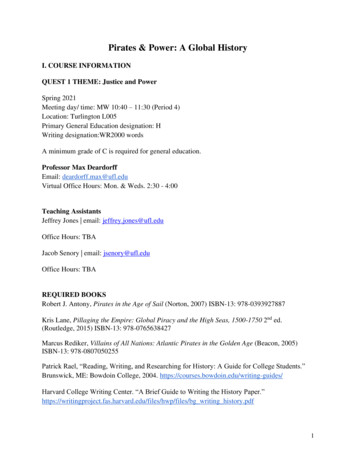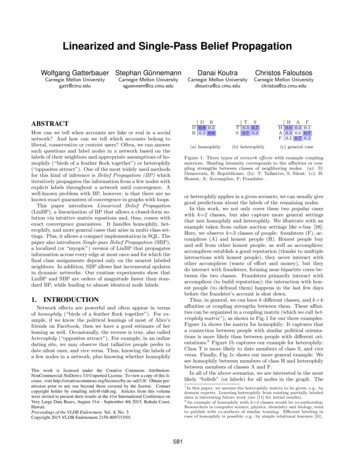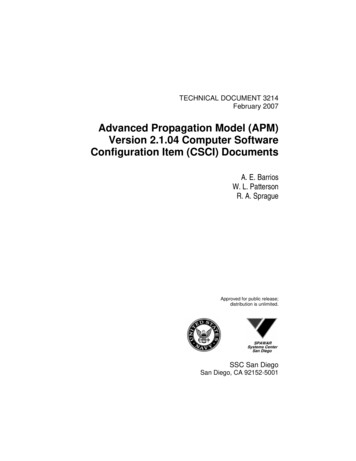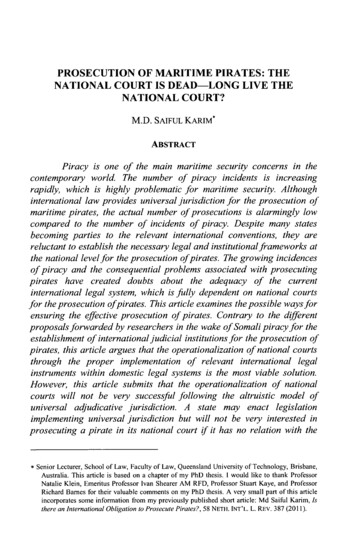
Transcription
NO. 937JULY 2020REVISEDJULY 2021Pirates without Borders:The Propagation ofCyberattacks throughFirms' Supply ChainsMatteo Crosignani Marco Macchiavelli André F. Silva
Pirates without Borders: The Propagation of Cyberattacks through Firms' Supply ChainsMatteo Crosignani, Marco Macchiavelli, and André F. SilvaFederal Reserve Bank of New York Staff Reports, no. 937July 2020; revised July 2021JEL classification: L14, E23, G21, G32AbstractWe document the supply chain effects of the most damaging cyberattack in history. The disruptionspropagated from the directly hit firms to their customers, causing a four-fold amplification of the initialdrop in profits. These losses were larger for affected customers with fewer alternative suppliers. Internalliquidity buffers and increased borrowing, mainly through bank credit lines, helped firms navigate theshock. The cyberattack also led to persisting adjustments to the supply chain network, with affectedcustomers more likely to create new relationships with alternative suppliers and terminate those with thedirectly hit firms.Key words: cyberattacks, supply chains, bank creditCrosignani: Federal Reserve Bank of New York (email: matteo.crosignani@ny.frb.org). Macchiavelli,Silva: Board of Governors of the Federal Reserve System (email: marco.macchiavelli@frb.gov,andre.f.silva@frb.gov). The authors thank Viral Acharya, Tania Babina, Miguel Faria-e-Castro,Mariassunta Giannetti, Michael Gofman, Huiyu Li, Nicola Limodio, Vojislav Maksimovic, AndreasMilidonis, Camelia Minoiu, Patricia Mosser, Andreas Papaetis, Brian Peretti, Andrea Presbitero, JulienSauvagnat, Stacey Schreft, Antoinette Schoar, Jialan Wang, and conference and seminar participants atthe 2021 NBER Corporate Finance Spring Meeting, London School of Economics, 2020 Federal ReserveSystem Conference on Financial Institutions, Regulation, and Markets, 2020 OFR/Cleveland FedFinancial Stability Conference, EBRD, Federal Reserve Board, NY Fed, University of Sussex, 2020 Bankof Italy/FRB Conference on Nontraditional Data & Statistical Learning, 2020 EBA Policy ResearchWorkshop, 2021 SGF Conference, Bank of Italy, ifo Institute - University of Munich, HumboldtUniversity of Berlin, and 2021 IBEFA Summer Meeting for their comments. They also thank WilliamArnesen and Frank Ye for excellent research assistance.This paper presents preliminary findings and is being distributed to economists and other interestedreaders solely to stimulate discussion and elicit comments. The views expressed in this paper are those ofthe author(s) and do not necessarily reflect the position of the Federal Reserve Bank of New York or theFederal Reserve System. Any errors or omissions are the responsibility of the author(s).To view the authors’ disclosure statements, visithttps://www.newyorkfed.org/research/staff reports/sr937.html.
1IntroductionCybercrime is now one of the most pressing concerns for firms.1 Hackers perpetrate frequentransomware attacks mostly for financial gains, while state-actors often use more sophisticatedtechniques to obtain strategic information such as intellectual property and, in more extremecases, to disrupt the operations of critical organizations. Cyberattacks that are severe enoughto disrupt the integrity of IT systems can spread instantaneously without warning signs, areoften not geographically clustered, and can ultimately damage firms’ productive capacityand thus also potentially affect their customers and suppliers. However, despite these uniquefeatures and their growing importance, there is little empirical evidence on the potentiallydisruptive effects of cyberattacks on the productive sector.In this paper, we study a particularly severe cyberattack that inadvertently spread beyondits original target and disrupted the operations of several firms around the world. Throughsupply chain relations, the effects of the cyberattack propagated downstream to the customersof directly hit firms.2 To cope with the shock, affected customers used their liquidity buffersand increased their reliance on external finance, drawing down their credit lines at banks.We also observe persisting adjustments to the supply chain network in response to the shock,with affected customers more likely to create new relationships with alternative suppliers andterminate those with the directly hit firms.More specifically, we examine the impact of the most damaging cyberattack in history sofar (Greenberg, 2018, 2019).3 Named NotPetya, it was released on June 27, 2017 and targetedUkrainian organizations in an effort by the Russian military intelligence to cripple Ukrainian1For instance, the latest World Economic Forum Executive Opinion Survey ranks cyberattacks as thenumber one risk for CEOs in North America and Europe (WEF, 2019).2We refer to customers (suppliers) of directly hit firms as affected customers (suppliers) throughout.3See also a newspaper article tpetya-attribution/)and an assessment by Kaspersky s-cyberattacks/24506/).1
critical infrastructure. The initial vector of infection was a software that the Ukrainiangovernment required all vendors in the country to use for tax reporting purposes. When thissoftware was hacked and the malware released, it spread across different companies, includinglarge multinational firms through their Ukrainian subsidiaries. For instance, the shippingcompany Maersk had its entire operations coming to a halt, creating chaos at ports aroundthe globe. A FedEx subsidiary was also affected, becoming unable to take and process orders.Manufacturing, research, and sales were halted at the pharmaceutical giant Merck, making itunable to supply vaccines to the Center for Disease Control and Prevention (CDC). Severalother large companies (e.g., Mondelez, Reckitt Benckiser, Nuance, Beiersdorf) had theirservers down and could not carry out essential activities.First, we show that the halting of operations among the directly hit firms had a significantnegative effect on the productive capacities of their customers around the world, whichreported significantly lower profits. A conservative estimate implies a 7.3 billion loss bythe affected customers, an amount four times larger than the losses reported by the firmsdirectly hit by the cyberattack. Faced with this temporary shock, affected customers depletedsome of their pre-existing liquidity buffers and increased the amount of external borrowing,allowing them to maintain investment and employment. While the downstream disruptionsto customers were severe, we do not find significant upstream effects to the suppliers of thedirectly hit firms, nor downstream effects to the customers of the affected customers.Second, we investigate the role of supply chain vulnerabilities in driving these effects.We find that the downstream disruption caused by the cyberattack is concentrated amongcustomers that have fewer alternatives for the directly hit supplier. This result holds bothwhen considering how many other suppliers a customer has in the same industry of the directlyhit supplier, and when focusing on suppliers of less substitutable goods and services—that is,suppliers providing high-specificity inputs.Third, we analyze in detail the role of banks in mitigating the negative liquidity effects ofthe cyberattack on affected customers. To this end, we use confidential credit register data2
for the US (i.e., the Y-14Q corporate schedule), with loan-level information at a quarterlyfrequency for banks with total assets of more than 50 billion. While there was no change incredit line commitments granted by banks, affected customers drew down relatively moreon their credit lines to compensate for the liquidity shortages. Interest rate spreads alsoincreased relatively more for affected customers, a result explained by an increase in risk, asmeasured by the expected probability of default that each bank assigns to a given firm.Finally, we examine the dynamic supply chain response to the disruption caused by thecyberattack. We find that affected customers are more likely to form new trading relationshipswith firms in the same industry as the directly hit supplier after the shock. This resultsuggests that the disruption caused by the cyberattack served as a “wake-up call” for theaffected customers which responded by finding alternative suppliers. We also find thatthe affected customers are more likely to end their trading relationship with the suppliersdirectly hit by the cyberattack, thus suggesting that the temporary disruptions caused bythe cyberattack had long-lasting effects by eroding the reputation of the directly hit firms asreliable suppliers.Our paper contributes to the nascent literature on the economics of cybercrime—an areathat is getting increasing attention by both practitioners (Accenture, 2019; Verizon, 2019;Siemens, 2019; NERC, 2020) and policymakers (US Congress, 2021; Powell, 2021). Theacademic literature has mostly focused on examining the effects of cyber risk on financialstability (Kashyap and Wetherilt, 2019; Duffie and Younger, 2019; Kopp, Kaffenberger andWilson, 2017; Aldasoro et al., 2020; Eisenbach, Kovner and Lee, 2021) and developing firmlevel measures of exposure to cyber risk using textual analysis (Jamilov, Rey and Tahoun,2021; Florakis et al., 2020). Other related papers study abnormal equity returns followingdata breaches (Kamiya et al., 2021; Garg, 2020; Akey, Lewellen and Liskovich, 2021; Amir,Levi and Livne, 2018). While data breaches can lead to reputation, litigation, and othermonetary costs, like most cyberattacks, they usually do not disrupt firms’ operations. Incontrast to these studies, we focus on a far more damaging and larger-scale cyberattack3
resulting in operational disruptions and document its economic and financial effect, throughsupply chain linkages, on the productive sector at large. These disruptive cyberattacks arebecoming more and more frequent, as evidenced by the ransomware attacks on ColonialPipeline, the largest pipeline system for refined oil products in the United States, and JBS, aglobal beef processing company. In these cases, operations halted for several days, causingprotracted supply chain bottlenecks.4Our paper also complements the literature on the propagation of shocks through supplychains following severe shocks such as natural disasters (Barrot and Sauvagnat, 2016; Boehm,Flaaen and Pandalai-Nayar, 2019; Carvalho et al., 2021), pandemics (Bonadio et al., 2021),and financial crises (Alfaro, Garcı́a-Santana and Moral-Benito, 2021; Cortes, Silva andVan Doornik, 2019; Costello, 2020).5 Specifically, we show that large supply chain shockscan lead to a reconfiguration of the supply chain network as customers of directly hit firmsform new trading relationships with alternative suppliers and terminate relationships withthe directly hit firms. These results are especially relevant for the theoretical literature onendogenous production networks (Elliott, Golub and Leduc, 2020; Taschereau-Dumouchel,2020; Acemoglu and Tabhaz-Salehi, 2020). Relatedly, the cyberattack we study has several4Our paper is also related to the literature on intelligence and espionage. Berger et al. (2013) and Dube,Kaplan and Naidu (2011) study the effects of CIA influence on trade and stock returns for firms with aparticular interest in regime change, respectively. Martinez-Bravo and Stegmann (2021) use the CIA vaccinecampaign to verify a target’s DNA to show the effects of vaccine distrust on immunization, Ahn and Ludema(2020) document the effects of sanctions related to the Russian annexation of Crimea, Lichter, Löffler andSiegloch (2021) examine the effect of state surveillance on civic capital and economic performance, while Glitzand Meyersson (2020) estimate the economic returns resulting from state-sponsored industrial espionage.5Boehm, Flaaen and Pandalai-Nayar (2019) exploit an earthquake in Japan and estimate a near zeroelasticity of substitution of intermediate goods in the short-run, while Carvalho et al. (2021) use the sameshock to map its propagation patterns through supply chains. Barrot and Sauvagnat (2016) document thatsuppliers hit by natural disasters propagate the shock downstream as well as horizontally. Costello (2020)finds that firms facing financing constraints transmit shocks downstream via declines in trade credit. Cortes,Silva and Van Doornik (2019) show that firms borrowing from more stable funding sources benefit both theirsuppliers and customers. Finally, Alfaro, Garcı́a-Santana and Moral-Benito (2021) show how bank creditsupply shocks that affect borrowing firms are propagated downstream to their customers. However, they findmixed evidence on upstream propagation.4
advantages relative to the more commonly analyzed shocks. On the one hand, natural disasterstend to follow seasonal and geographical patterns, making the identification particularlychallenging. On the other hand, pandemics and credit supply shocks are often slower-movingand hit several firms at the same time, causing the effects to be likely driven by both demandand supply forces. Instead, NotPetya is more unpredictable and faster to materialize, occursamid normal economic conditions, and affects different geographical regions.2Background on NotPetyaIn the intelligence world, few things are what they seem. Petya is the name of a ransomwarethat circulated in 2016. The victim was infected after opening a PDF file purporting tobe the resume of a job applicant and, from there, the ransomware encrypted the masterfile table which serves as a roadmap for the hard drive, making the data on the computerunreachable. The victim was then asked to make a Bitcoin payment to get the hard drivedecrypted. What seemed to be a new version of Petya spread quickly in June 2017. It hitUkraine the hardest but it also appeared worldwide. However, this new version was able tospread across networks, without requiring to obtain administrative access. Even though itappeared to be just another ransomware, as shown in Figure A.1 in the Online Appendix,it was quickly found out that the real intent was not the financial gain from the ransompayment. Indeed, the attack was not even designed to keep track of the decryption codes.Instead, the true intent was to encrypt and paralyze the computer networks of Ukrainianbanks, firms, and government. This was not a new version of Petya.This cyberattack was the hand of a hacking group from the Russian military intelligence,the GRU. The Russian government had been actively involved in meddling in Ukrainianmatters since Ukraine, previously part of the Soviet Union, took steps to build closer tiesto NATO. Initially, Russia directed a series of cyberattacks to Ukraine, including its powergrid, and then resorted to military action by invading and annexing Crimea. It should also5
be noted that the timing of the NotPetya attack was in a way serendipitous. The ease withwhich NotPetya spread from network to network without human intervention depended ona never-seen-before piece of code that was leaked in April 2017 by the Shadow Brokers, ahacking group. The leaked code, called Eternalblue, is a very sophisticated tool developed bythe NSA to harvest passwords and move from network to network. Eternalblue was usedtogether with another tool, Mimikatz, that was already circulating among hackers and canfind network administrator credentials stored in the infected machine’s memory.6NotPetya was itself a supply chain attack, in the sense that the initial point of entry wasa backdoor planted in an accounting software, called M.E. Doc, widely used by Ukrainianfirms for tax reporting. As a result, most companies operating in Ukraine got infected,including multinational companies through their Ukrainian subsidiaries.7 More generally,Moody’s (2020) argues that companies with less sophisticated cybersecurity are at risk ofattacks stemming from suppliers and vendors with access to their IT systems. For instance, acompromised software company can become a vector through which thousands of customers’computers are infected, as in the case of NotPetya.3DataWe use several data sources to conduct our analysis at both the firm- and loan-level, includingglobal supply chain relationships data from FactSet Revere, balance sheet data on firmsworldwide from Orbis, and credit register data for the US from the Federal Reserve’s Y-14Q.First, to identify the firms directly affected by NotPetya, we start by web scraping6Microsoft released a patch for Eternalblue prior to the NotPetya incident. However, NotPetya couldinfect unpatched computers, grab the passwords via Mimikatz, and spread to patched computers. Many firmsreportedly do not update regularly for fear that the updates could interfere with their software.7More details about NotPetya can be found in Greenberg (2019), a book about NotPetya and othercyberattacks conducted by Russian military intelligence on Ukraine in 2014–2017.6
Firm NameBeiersdorfAssets: 7.69 blnCosts 43 mlnFedExAssets: 33.07 bln 400 mlnMaerskAssets: 68.84 bln 300 mlnMerckAssets: 98.17 bln 670 mlnMondelezAssets: 66.82 bln 180 mlnNuanceAssets: 5.82 bln 92 mlnReckitt Benckiser 117 mlnAssets: 24.19 blnWPPAssets: 41.55 bln 15 mlnAdditional DetailsVarious locations of the Beiersdorf pharmaceutical group were cutoff from mail traffic for days. Beiersdorf said 35 million euros worthof second quarter sales were delayed to the third quarter and it wastotting up the costs of the attack for items such as calling in outsideexperts, promotions, and using other production sites to make up forshortfalls.Delivery service FedEx lost 400 million after NotPetya crippled itsEuropean TNT Express business. The reported costs came from lossof revenue at TNT Express and costs to restore technology systems.Six weeks after the attack, customers were still experiencing serviceand invoicing delays, and TNT was still using manual processes inoperations and customer service.Maersk reinstalled 4,000 servers, 45,000 PCs, and 2,500 applicationsover ten days. The company only experienced a 20% drop in volume,while the remaining 80% of operations were handled manually. Losseswere about 300 million, including loss of revenue, IT restoration costs,and extraordinary costs. The company was hiring 26 new employees aweek, planning to have 4,500-5,000 IT employees within 18 months. AtMaersk terminals in the Port of New York and New Jersey, computers,phones, and gate system shut down, forcing workers to use paperdocuments.At Merck, NotPetya temporarily disrupted manufacturing, researchand sales operations, leaving the company unable to fulfill orders forcertain products, including vaccines. The attack cost Merck about 670 million in 2017, including sales losses and manufacturing andremediation-related expenses.The global logistics chain of the food company Mondelez was disruptedby NotPetya. The forensic analysis and restoration of all IT networkscost 84 million. Added to this was the loss of sales. AltogetherMondelez had to record 180 million of damage by the attack.NotPetya affected Nuance’s cloud-based dictation and transcriptionservices for hospitals. Nuance estimated a negative impact of 68million in lost revenues and 24 million in restoration costs.Reckitt Benckiser was hit by NotPetya, halting production, shippingand invoicing at a number of sites. The British consumer goodscompany suffered 117 million in losses, 1% of annual sales.UK multinational advertising firm WPP was hit by NotPetya, costingabout 15 million before insurance. The damage was limited by thefact that WPP’s systems are not fully integrated.Table 1: Firms Directly Affected by NotPetya. Firms directly affected by NotPetya, total assets,total reported costs associated with NotPetya, and additional details. Sources: SEC Filings and Dow JonesFactiva.7
SEC filings in 2017 and 2018.8 We experiment with different keywords, including “Petya”,“NotPetya”, and “Cyber.” Among the filings that contain a match, we exclude matches thatare unrelated, such as cybersecurity firms citing NotPetya as the main cyberattack of theyear. We also look for instances in which NotPetya is cited in newspaper articles worldwide.Using the Dow Jones Factiva database that contains a repository of international newspaperarticles, we obtain over 4,500 relevant articles which we manually check for stories of firmsdirectly hit by NotPetya. Finally, we cross-check the list of directly hit firms with Greenberg(2019). We exclude firms in Ukraine, Russia, as well as non-public firms that we would not beable to find in other data sets, e.g., government agencies and hospitals. Overall, as describedin detail in Table 1, we identify 8 public firms that were directly hit by NotPetya—includingFedEx, Maersk, Merck, Mondelez, as well as other very large companies in the US, UK,Germany, and Denmark.9 In Figure 1, we show that the stock price of these directly hit firmscollapsed by 5% after they disclosed the damages of NotPetya.Second, we obtain global supply chain relationships data from FactSet Revere, arguably themost comprehensive source of firm-level customer-supplier relationships currently available.10Specifically, the data set includes almost a million relationships between large (mostly publiclylisted) firms around the world. Each customer-supplier relationship has information on thestart date, end date, and relationship type. FactSet collects this information through the8Starting in 2005, the Securities and Exchange Commission (SEC) required publicly traded firms todisclose material factors that may adversely affect their business, operations, or future performance in 10-Kfilings (providing updates in the subsequent 10-Qs).9We show the geographical distribution of these directly hit firms in Figure A.2 in the Online Appendix.We do not consider the customers and suppliers of DLA Piper and Saint-Gobain in our specifications sincethis information is not available in Factset Revere—in the latter case, supply chain data is only availableafter the shock. Other companies reportedly hit by the cyberattack, though to a much small extent, includethe Italian Buzzi Unicem and the German Deutsche Bahn and Deutsche Post. These firms are also excludedfrom our analysis due to the lack of supply chain information both before and after the shock.10Alternative sources of supply-chain data either do not have information with sufficiently high-frequencyon the start and end dates of a relationship between two firms (e.g., Bloomberg, Capital IQ) or are not asgranular as FactSet (e.g., Compustat Segment data which only reports, with an annual frequency, the largestcustomers of a supplier).8
100989694Stock Price Index102Stock Price of Directly Hit Firms 6 4 20 2 4 6Figure 1: Stock Price of Directly Hit Firms Around News of the Damages of NotPetya. Thisfigure shows the stock price evolution around the news of the damages of NotPetya (from seven trading daysprior to the news to seven days after the news). Stock prices are averaged across firms and normalized to 100seven trading days before the disclosure of the news. The dashed lines indicate the standard errors aroundthe mean. The dates when the news of the damages were publicly released are as follows: August 16, 2017for Moller-Maersk (link); August 2, 2017 for Beiersdorf (link); June 28, 2017 for Mondelez (link); August22, 2017 for WPP (link); June 28, 2017 for Nuance (link); July 16, 2017 for FedEx (link); July 5, 2017 forReckitt Benckiser (link); October 26, 2017 for Merck (link). Source: Datastream.firms’ public filings, investor presentations, websites, corporate actions, press releases, andnews reports. Following Gofman, Segal and Wu (2020), we drop redundant relationshipswhose start and end dates fall within the period of a longer relationship between the samefirm pair and combine multiple relationships between two firms into a continuous relationshipif the time gap between two relationships is shorter than six months. Using each firm’sInternational Securities Identification Number (ISIN), we are able to identify a total of 233customers and 320 suppliers indirectly affected by the cyberattack, i.e. exposed through theirsupply chain connections to directly hit firms.11Third, we collect balance sheet and income statements information on firms worldwide11We show the geographical distribution of affected customers and affected suppliers in Figure A.3 andFigure A.4 in the Online Appendix.9
from Orbis—a database by Bureau Van Dijk (part of Moody’s Analytics) that contains datafor more than 350 million companies globally. In addition to its extensive coverage, Orbis isparticularly attractive due to its cross-country comparability since the data provider organizesthe information in a standard global format (Kalemli-Ozcan et al., 2019). We merge Orbiswith FactSet using the ISIN of each firm and disregard companies that are not present inboth data sets to avoid selection bias due to the inclusion of smaller listed firms that appearin Orbis but that do not report supply chain relations. In addition, as it is standard inthe literature, we remove financial firms and firms in the government sector. We obtain anintersection of 70,590 firm-year observations, corresponding to 15,781 firms from 2014 to2018, the most recent date available in Orbis.Finally, we obtain loan-level information on bank credit to firms from the corporate loanschedule (H.1) of the Federal Reserve’s Y-14Q. These data have been collected since 2012 tosupport the Dodd-Frank Act’s stress tests and assess bank capital adequacy for large banksin the US. The credit register provides confidential information at the quarterly frequency onall credit exposures exceeding 1 million for banks with more than 50 billion in assets. Theseloans account for around 75% of all commercial and industrial (C&I) lending volume duringthe period we analyze. In addition to the amount of committed credit for each firm-bankpair, the data set also contains information on the committed and drawn amounts on creditlines, the amount that is past due, as well as information on other loan characteristics, suchas the interest rate spread, maturity, and collateral. Finally, we also have information oneach bank’s internal assessment of the default probability of a given firm—a model-basedmetric that captures the bank’s hard information about a given borrower and that predictsloan delinquency (Adelino, Ivanov and Smolyansky, 2020).In order to identify firms indirectly affected by the cyberattack, we merge these firmbank data for the US with Orbis and FactSet using the firms’ tax identification numbersand CUSIPs available in the Y-14Q. This results in a sample of 137,630 bank-firm-quarterobservations from 2014:Q1 to 2018:Q4, covering 37 banks and 1,997 firms. Of these, 85 are10
customers of firms directly hit by the cyberattack, corresponding to 87% of US customers inthe Orbis-FactSet firm-level sample.4Identification Strategy4.1Firm-level AnalysisOur goal is to document the effects of the NotPetya cyberattack through the supply chain.Given that the attack caused the directly hit firms to halt operations for several weeks, weare interested in estimating the effects on these firms’ customers and suppliers, which we referto as affected customers and affected suppliers. We use a difference-in-differences approach,comparing the change in behavior of firms indirectly affected by the shock through theirsupply chain with that of unaffected firms operating in the same industry, country, and sizequartile in the same year. Specifically, we estimate the following specification:Yijt α βPostt Affectedi ξi ηjt ijt(1)where i corresponds to a firm, t to a year, and j to the peer group of firm i—an industrycountry-size quartile combination in the baseline case, with industries defined at the SIC2-level.The sample period runs from 2014 to 2018. Yijt is one of several outcome variables we consider,including the ratio of earnings before interest and taxes (EBIT) to total assets, the ratioof long-term debt to total assets, and the liquidity ratio (current assets minus inventoriesover current liabilities). Affected i is a firm-level indicator variable equal to one if a firm isconnected (as a supplier or as a customer) to a directly hit firm. P ost equals one for 2017 and2018, the two time periods after the June 2017 cyberattack. We estimate the β coefficientwithin a peer group, captured by the fixed effects ηjt .In robustness tests, we consider alternative peer groups of firms that in the current year are11
in the same industry (or country) and size quartile of the treated firm and, in addition, havea supply chain link with a firm in the same industry of a directly hit firm. This requirementensures firms in the control group are not only in the same industry/country and size quartileof the treated firm, but they also use comparable suppliers. We also include firm fixed effectsξi . Standard errors are double clustered at the industry and country level.The NotPetya cyberattack hit many firms in Ukraine, including the Ukrainian subsidiariesof international firms, and then spread to the entire network infrastructure of most of thesecompanies, affecting their global operations. Importantly for our identification strategy, theattack came from a third party vendor, whose software is widely used in Ukraine for taxfiling purposes. Hence, within the set of international firms, it is plausible to assume thatthe attack was unrelated to firm characteristics. Nevertheless, one may still argue that theseverity with which each firm was hit depends on the adoption of best practices to improvecybersecurity, or “cyber-hygiene.” However, we go one step further and study the effect oncustomers and suppliers of the directly hit firms. As a result, even if the severity of the attackon the directly hit
The initial vector of infection was a software that the Ukrainian government required all vendors in the country to use for tax reporting purposes. When this software was hacked and the malware released, it spread across di erent companies, including large multinational rms through their Ukrainian subsidiaries. For instance, the shipping










